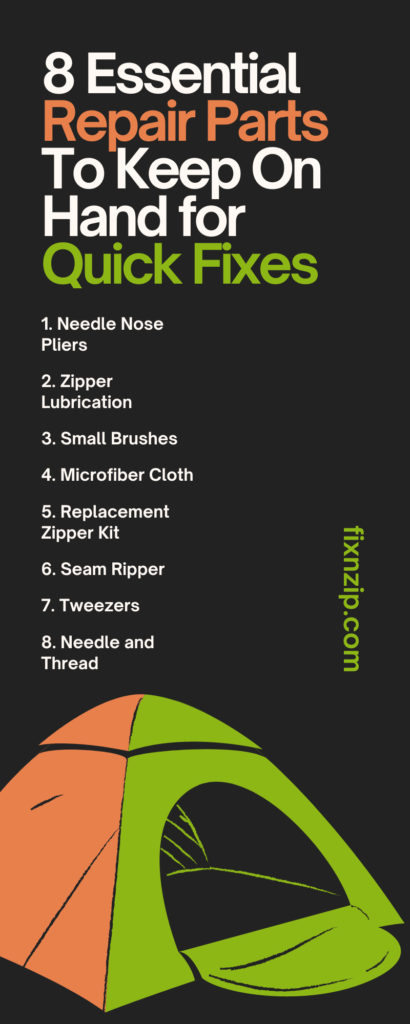
There are times when you may find yourself in need of a quick zipper repair. Whether you want to fix the front of your favorite jacket since the days are getting colder or need to fix your tent before you head out on your big camping trip, having working zippers is vital.
In many cases, you can take your garments or other items to a tailor or other professional who can make the repairs for you. However, in the time it takes you to look up a place to bring your busted zipper, you may have been able to fix it yourself.
There are some jobs where a professional may be the right option, but you can take care of plenty of minor repair tasks from your kitchen table. Here are eight essential repair parts to keep on hand for quick fixes so you can save time and money by repairing your zippers at home.
A good pair of pliers is one of the most helpful tools to have when making repairs. Many people prefer to use needle nose pliers because the thin tip makes them easier to work with and grip onto a more precise area. It may be a good idea to have a couple of different sizes so you can choose which works better for the item you're trying to repair.
Many zippers, especially those found on jackets, stay attached to the garment thanks to a top and bottom stop that prevents them from sliding off. If you’re making repairs, needle nose pliers are good for disconnecting these stoppers so that you can put on a new slider and reattach the new stoppers by bending the teeth into the fabric.
In some instances, the teeth on the main track of a zipper may become bent or crooked. A precise pair of needle nose pliers allow you to make quick and easy adjustments to form the metal closer to its original positioning. Having a few pairs of pliers is crucial if you're putting together a small toolbox for zipper repair.
In many situations, a zipper isn’t broken in the traditional sense but stuck or jammed, so you can't open or close it very well. In these situations, it helps to have some lubrication in your kit, and you might be able to fix it without much issue.
You can buy specialized zipper lubrication online or at most craft or hobby stores, and applying a little of the lubrication to both sides of the zipper track and then gently sliding the pull up and down to get it moving is one option to get it working again. We recommend having some of this lubrication available, but if you don’t, there are a couple of other options.
A few ways to loosen and lubricate a zipper without the designated product are to use a few drops of olive oil around the zipper pull or to rub gently on both sides of the zipper with a graphite pencil.
Depending on the condition of the area you store your items in, the zipper may collect dirt, dust, or other similar debris. Often, one of the main reasons a zipper may become jammed or stuck is from these irritants getting caught in the teeth and inside the slider.
When you’re repairing a stuck zipper like this, it helps to have a small, soft-bristled brush to clear the build-up. A toothbrush will work as a good solution, but other brushes you can find at hobby stores might be good for the long run.
When you're repairing zippers, after brushing and lubricating, you may want something to clean everything off or help dry them after using oil. A small microfiber cloth in your repair kit enables you to tidy up and continue with any further steps in the repair process without having to wait for the zipper to dry. We recommend a microfiber cloth because the delicate fibers will not scratch or damage the metal, leading to further problems.
A good repair kit is one of the most important things when you’re gathering the essential repair parts to keep on hand for quick fixes. Repair kits typically come with at least one replacement slider for the size you need and spare top and bottom stops.
The individual pieces may vary from kit to kit, and some may come with spare tape and teeth if you need to completely replace the zipper instead of just the slider. If you need help determining what size zipper pull you need, you may often see a size number written on the base of the slider to give you an idea of where to start. We recommend keeping a few spares on hand in some of the more common sizes if you want to be able to make quick repairs.
There are times when you may need to remove the entire track of the zipper, and one of the easiest ways to do that is to grab a seam ripper and carefully pull out the threads connecting your zipper to the garment or other item. Seam rippers allow you to separate the zipper while minimizing overall damage to the rest of the time.
When you're making quick repairs and removing the zipper tape, having a pair of tweezers or a similar tool allows you to pluck out lingering threads that may remain in the fabric you want to remove.
Having a needle and thread on hand is crucial if you need to sew in a new zipper track. If you know how to sew, attaching a new zipper or attempting to affix a ripped portion back to the main body of your item is easier with a needle and thread. It helps to have a couple of different thread colors to closely match the main fabric and keep things from standing out too much.
To learn more about how to fix a zipper and the tools you need to make those repairs, FixnZip has everything you need. We have helpful blog posts covering various topics and several practical replacement zipper parts to add to your kit. For more details, contact us anytime, and a helpful, friendly member of our staff will be happy to help you find the information you need.

